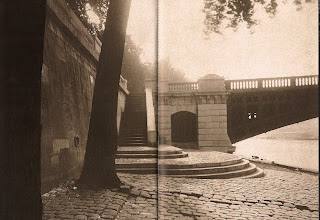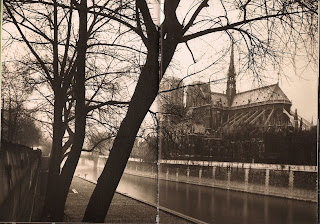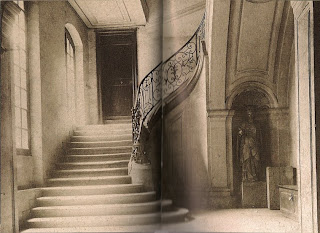
Over the last summers and winters, New York photographer Christopher Flach has been photographing French chateaux and their gardens. His black and white (and sometimes sepia) images are oneiric, original, classical, and elegant—and I have been collecting them for several years. Like me, Chris is a Francophile.

For many years, Chris Flach has been creating haunting and elegiac images of the gardens, statuary, trees, ponds and fountains of classic chateaux in the Ile-de-France, Versailles and south to Melun.
A restless artist, he has also recently been working on two self-published books: New York City neon and New York city trucks and ATM machines. Yes—from Vaux-le-Vicomte to bank machines.
On moody, cloudy, softly-lit days, he would spend his time alone (no assistant, ever) scouting topiaries and grottos and plinths and urns, and photographing hidden corners of Saint-Cloud, Vaux-le-Vicomte, and Versailles.
“I have always admired the photography of Eugene Atget, and so Saint-Cloud, which he shot many times, will be forever in my memory associated with Atget,” said Flach.


Saint-Cloud is a formal garden of the same vintage as Versailles, and superbly maintained, but bereft of its chateau.
“Without its grandeur and pomp it is rather unknown today—except for the Grande Cascade. Saint-Cloud for me was really about the woods, the terraced balustrades, the allees, and the pools,” said Flach. “I was drawn to its naiveté, its natural beauty, its childish intelligence.”
Flach said that photographing at Saint-Cloud, often with the sun behind him, he was very conscious of the dazzle of grand environs—a theme that continued to Versailles.
“I spent more many days at Versailles, where I spent less time on reflection and more time on intuition,” said Flach. A favorite location was the music pavilion (shown here, with a cherub fountain in the foreground.)

“Versailles was all about splendor—a feudal fortress built to withstand a siege, with its walls and moats,” he said. “I was always aware, even if I was shooting an urn or fountain, of the whole history of Louis XIV, the sun king, and the engineering genius Le Prestre de Vauban. My images were about simplicity of composition, tones, and subject.”
Flach noted that as he developed the images, he discovered that his images suggest a bittersweet melancholy.
“Inside the images and my work are more private, more complex and infinitely about the personal,” said the photographer. “My images are about my ideas, my determination and my sense of awe from the creative work that was done.”



Flach said that in his work he wanted to achieve atmosphere, resonance, and mystery, as well as a lush expression of a moment of time.
I’ve always loved these perfectly composed and quiet pictures—and private moments of reflection of gardens and objects that have been overly photographed and fetishized. They’re a walk in the park on a rainy fall afternoon. They invoke a sense of time passing, a meditation on life and death, and encourage a quiet review of the seasons and times of day. Without trying too hard, they are also very wonderfully French.
All photographs by Christopher Flach, www.chrisflach.com. Contact: 415-225-9476. He lives in New York, on the Upper East Side.
Atget Inspiration
New York photographer Christopher Flach was inspired by French photographer, Eugene Atget, as he photographed statuary at Versailles, trees in the Tuileries, a trianon or two, and the delights of Paris parks.
Atget (1857-1927) traipsed through Paris and the surrounding parks and palaces to craft sublime black and white images using glass plates, hand-coated emulsion, and bags of all the laborious accouterments and chemicals he needed to make just one image.
Working at a time when the handcrafted picture was his métier, Atget recorded corners of Paris that are lost—as well as Paris scenes I walk past every day when I am in Paris. He took a fabulously dramatic image of the wedge-shaped corner of rue de Seine and rue de l’Echaude that still looks basically the same almost 100 years later. The Notre-Dame scene, shown here, is precisely as it was in 1922. The Jardin de Tuileries is presented in an enigmatic image and the formal layout and statuary is all there today.
Atget was a commercial photographer—producing fine art, in fact—who spent more than thirty years finding and crafting more than 8,000 pictures of Paris before he died in 1927. He was unknown during his lifetime.
Like Atget, Flach is looking for a serene clarity in his work—the opposite of a glossy image. Working in black and white and carefully supervising each print, Flach, like Atget, seeks out hidden corners of Paris and Versailles, far from the obvious postcard pictures.
These are photographs that are quiet, timeless, and utterly beautiful.
Photographs by Eugene Atget include a stairway in the Hotel du Marquis de Lagrange, 1901; Notre-Dame and the Seine in winter, 1922; statuary and chairs in the Jardin des Tuileries, 1907; lines of trees in the Jardin de Luxembourg,1903; and the riverbank at the Porte des Tuileries, 1913. From Paris Style (Taschen).




